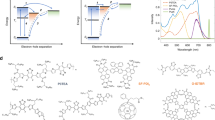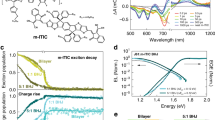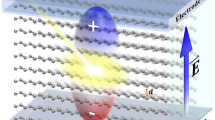Abstract
Photocurrent generation in organic photovoltaics (OPVs) relies on the dissociation of excitons into free electrons and holes at donor/acceptor heterointerfaces. The low dielectric constant of organic semiconductors leads to strong Coulomb interactions between electron–hole pairs that should in principle oppose the generation of free charges. The exact mechanism by which electrons and holes overcome this Coulomb trapping is still unsolved, but increasing evidence points to the critical role of hot charge-transfer (CT) excitons in assisting this process. Here we provide a real-time view of hot CT exciton formation and relaxation using femtosecond nonlinear optical spectroscopies and non-adiabatic mixed quantum mechanics/molecular mechanics simulations in the phthalocyanine–fullerene model OPV system. For initial excitation on phthalocyanine, hot CT excitons are formed in 10−13 s, followed by relaxation to lower energies and shorter electron–hole distances on a 10−12 s timescale. This hot CT exciton cooling process and collapse of charge separation sets the fundamental time limit for competitive charge separation channels that lead to efficient photocurrent generation.
This is a preview of subscription content, access via your institution
Access options
Subscribe to this journal
Receive 12 print issues and online access
$259.00 per year
only $21.58 per issue
Buy this article
- Purchase on Springer Link
- Instant access to full article PDF
Prices may be subject to local taxes which are calculated during checkout




Similar content being viewed by others
References
Brédas, J-L., Norton, J. E., Cornil, J. & Coropceanu, V. Molecular understanding of organic solar cells: The challenges. Acc. Chem. Res. 42, 1691–1699 (2009).
Vandewal, K., Tvingstedt, K., Gadisa, A., Inganäs, O. & Manca, J. V. On the origin of the open-circuit voltage of polymer–fullerene solar cells. Nature Mater. 8, 904–909 (2009).
Zhu, X-Y., Yang, Q. & Muntwiler, M. Charge-transfer excitons at organic semiconductor surfaces and interfaces. Acc. Chem. Res. 42, 1779–1787 (2009).
Clarke, T. M. & Durrant, J. R. Charge photogeneration in organic solar cells. Chem. Rev. 110, 6736–6767 (2010).
Morteani, A. C., Sreearunothai, P., Hertz, L. M., Friend, R. H. & Silva, C. Exciton regeneration at polymeric semiconductor heterojunctions. Phys. Rev. Lett. 92, 247402 (2004).
Tvingstedt, K. et al. Electroluminescence from charge transfer states in polymer solar cells. J. Am. Chem. Soc. 131, 11819–11824 (2009).
Loi, M. A. et al. Charge transfer excitons in bulk heterojunctions of a polyfluorene copolymer and a fullerene derivative. Adv. Funct. Mater. 17, 2111–2116 (2007).
Vandewal, K. et al. The relation between open-circuit voltage and the onset of photocurrent generation by charge-transfer absorption in polymer: fullerene bulk heterojunction solar cells. Adv. Funct. Mater. 18, 2064–2070 (2008).
Drori, T. et al. Below-gap excitation of π-conjugated polymer–fullerene blends: Implications for bulk organic heterojunction solar cells. Phys. Rev. Lett. 101, 037401 (2008).
Ford, T. A., Ohkita, H., Cook, S., Durrant, J. R. & Greenham, N. C. Direct observation of intersystem crossing in charge-pair states in polyfluorene polymer blends. Chem. Phys. Lett. 454, 237–241 (2008).
Wilke, A. et al. Electric fields induced by energy level pinning at organic heterojunctions. Appl. Phys. Lett. 98, 123304 (2011).
Beljonne, D. et al. Electronic processes at organic-organic interfaces: Insight from modeling and implications for opto-electronic devices. Chem. Mater. 23, 591–609 (2011).
McMahon, D. P., Cheung, D. L. & Troisi, A. Why holes and electrons separate so well in polymer/fullerene photovoltaic cells. J. Phys. Chem. Lett. 2, 2737–2741 (2011).
Chen, W. et al. Hierarchical nanomorphologies promote exciton dissociation in polymer/fullerene bulk heterojunction solar cells. Nano. Lett. 11, 3707–3713 (2011).
Grancini, G. et al. Transient absorption imaging of P3HT: PCBM photovoltaic blend: Evidence for interfacial charge transfer state. J. Phys. Chem. Lett. 2, 1099–1105 (2011).
Yost, S. R., Wang, L-P. & Van Voorhis, T. Molecular insight into the energy levels at the organic donor/acceptor interface: A quantum mechanics/molecular mechanics study. J. Phys. Chem. C 115, 14431–14436 (2011).
Liu, A. et al. Control of electric field strength and orientation at the donor–acceptor interface in organic solar cells. Adv. Mater. 20, 1065–1070 (2008).
Peumans, P. & Forrest, S. R. Separation of geminate charge-pairs at donor–acceptor interfaces in disordered solids. Chem. Phys. Lett. 398, 27–31 (2004).
Gregg, B. A. Charged defects in soft semiconductors and their influence on organic photovoltaics. Soft Matter 5, 2985–2989 (2009).
Gregg, B. A. Entropy of charge separation in organic photovoltaic cells: The benefit of higher dimensionality. J. Phys. Chem. Lett. 2, 3013–3015 (2011).
Müller, J. G. et al. Ultrafast dynamics of charge carrier photogeneration and geminate recombination in conjugated polymer: Fullerene solar cells. Phys. Rev. B 72, 195208 (2005).
Bakulin, A. A. et al. The role of driving energy and delocalized states for charge separation in organic semiconductors. Science 335, 1340–1344 (2012).
Ohkita, H. et al. Charge carrier formation in polythiophene/fullerene blend films studied by transient absorption spectroscopy. J. Am. Chem. Soc. 130, 3030–3042 (2008).
Schoaee, S. et al. Acceptor energy level control of charge photogeneration in organic donor/acceptor blends. J. Am. Chem. Soc. 132, 12919–12926 (2010).
Lee, J. et al. Charge transfer state versus hot exciton dissociation in polymer–fullerene blended solar cells. J. Am. Chem. Soc. 132, 11878–11880 (2010).
Van der Hofstad, T. G. J., Di Nuzzo, D., van den Berg, M., Janssen, R. A. J. & Meskers, S. C. J. Influence of photon excess energy on charge carrier dynamics in a polymer–fullerene solar cell. Adv. Energy Mater. 2, 1095–1099 (2012).
Herrmann, D. et al. Role of structural order and excess energy on ultrafast free charge generation in hybrid polythiophene/Si photovoltaics probed in realtime by near-infrared broadband transient absorption. J. Am. Chem. Soc. 133, 18220–18233 (2011).
Tisdale, W. A. et al. Hot electron transfer from semiconductor nanocrystals. Science 328, 1543–1547 (2010).
Chan, W-L. et al. Observing the multi-exciton state in singlet fission and ensuing ultrafast multi-electron transfer. Science 334, 1541–1545 (2011).
Lobaugh, J. & Rossky, P. J. Computer simulations of the excited state dynamics of betaine-30 in acetonitrile. J. Phys. Chem. A 103, 9432–9447 (1999).
Sterpone, F., Bedard-Hearn, M. J. & Rossky, P. J. Nonadiabatic simulations of exciton dissociation in poly-p-phenylenevinylene oligomers. J. Phys. Chem. A 114, 7661–7670 (2010).
Xue, J., Rand, B. P., Uchida, S. & Forrest, S. R. A hybrid planar-mixed molecular heterojunction photovoltaics cell. Adv. Mater. 17, 66–71 (2005).
Akaike, K., Kanai, K., Ouchi, Y. & Seki, K. Impact of ground-state charge transfer and polarization energy change on energy band offsets at donor/acceptor interface in organic photovoltaics. Adv. Funct. Mater. 20, 715–721 (2010).
Tang, J. X., Zhou, Y. C., Liu, Z. T., Lee, C. S. & Lee, S. T. Interfacial electronic structures in an organic double-heterostructure photovoltaic cell. Appl. Phys. Lett. 93, 043512 (2008).
Kaake, L, Jailaubekov, A., Williams, K. & Zhu, X-Y. Probing ultrafast charge separation at organic donor/acceptor interfaces by a femtosecond electric field meter. Appl. Phys. Lett. 99, 083307 (2011).
Scholes, G. A. Insights into excitons confined to nanoscale systems: electron–hole interaction, binding energy, and photodissociation. ACS Nano 2, 523–537 (2008).
Dutton, G. J., Jin, W., Reutt-Robey, J. E. & Robey, S. W. Ultrafast charge-transfer processes at an oriented phthalocyanine/C60 interface. Phys. Rev. B 82, 073407 (2010).
Warshel, A. & Karplus, M. Calculation of ground and excited-state potential surfaces of conjugated molecules. 1. Formulation and parameterization. J. Am. Chem. Soc. 94, 5612–5625 (1972).
Tully, J. C. Molecular-dynamics with electronic-transitions. J. Chem. Phys. 93, 1061–1071 (1990).
Davidson, A. T. The effect of the metal atom on the absorption spectra of phthalocyanine films. J. Chem. Phys. 88, 168 (1982).
Kasha, M. J. Energy transfer mechanisms and the molecular exciton model for molecular aggregates. Radiat. Res. 20, 55–71 (1963).
Onsager, L. Initial recombination of ion pairs. Phys. Rev. 54, 554–557 (1938).
Xi, X. et al. A comparative study on the performances of small molecule organic solar cells based on CuPc/C60 and CuPc/C70 . Sol. Energy Mater. Sol. Cells 94, 2435–2441 (2010).
Sai, N. et al. Understanding the interfacial dipole field at the copper phthalocyanine (CuPc)/C60 interface: Theory and experiment. J. Phys. Chem. Lett. 3, 273–2177 (2012).
Lobaugh, J. & Rossky, P. J. Solvent and intramolecular effects on the absorption spectrum of betaine-30. J. Phys. Chem. A 104, 899–907 (2000).
Acknowledgements
The results reported here were based on work supported as part of the Understanding Charge Separation and Transfer at Interfaces in Energy Materials (EFRC:CST), an Energy Frontier Research Center funded by the US Department of Energy, Office of Science, Office of Basic Energy Sciences under Award Number DE-SC0001091. Sandia National Laboratories is a multi-program laboratory managed and operated by Sandia Corporation, a wholly owned subsidiary of Lockheed Martin Corporation, for the US Department of Energy’s National Nuclear Security Administration under contract DE-AC04-94AL85000. Computational resources were provided by TACC and NERSC.
Author information
Authors and Affiliations
Contributions
X-Y.Z. supervised the experiments. P.J.R. supervised QM/MM simulations; A.E.J. and L.G.K. carried out the TR-SHG experiments; J.R.T. and W-L.C. carried out the TR-2PPE experiments; A.P.W. carried out the QM/MM simulations; R.G. assisted in sample preparation; K.J.W. helped with experimental set-up; N.S. and K.L. carried out time-dependent density functional theory calculations. X-Y.Z., A.E.J. and A.P.W. wrote the manuscript.
Corresponding authors
Ethics declarations
Competing interests
The authors declare no competing financial interests.
Supplementary information
Supplementary Information
Supplementary Information (PDF 4509 kb)
Rights and permissions
About this article
Cite this article
Jailaubekov, A., Willard, A., Tritsch, J. et al. Hot charge-transfer excitons set the time limit for charge separation at donor/acceptor interfaces in organic photovoltaics. Nature Mater 12, 66–73 (2013). https://doi.org/10.1038/nmat3500
Received:
Accepted:
Published:
Issue Date:
DOI: https://doi.org/10.1038/nmat3500
This article is cited by
-
Physical insights into non-fullerene organic photovoltaics
Nature Reviews Physics (2024)
-
Structure-based screening of sp2 hybridized small donor bridges as donor: acceptor switches for optical and photovoltaic applications: DFT way
Journal of Molecular Modeling (2024)
-
Enabling robust and hour-level organic long persistent luminescence from carbon dots by covalent fixation
Light: Science & Applications (2022)
-
Sub-10-fs observation of bound exciton formation in organic optoelectronic devices
Nature Communications (2022)
-
There is plenty of room at the top: generation of hot charge carriers and their applications in perovskite and other semiconductor-based optoelectronic devices
Light: Science & Applications (2021)



